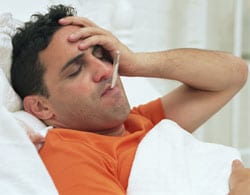Leptospirosis
is a bacterial disease spread by urine from infected animals, which can include
many different types of animals such as rodents, dogs, livestock and wildlife.
People can get leptospirosis when they have contact with soil or water
containing urine from infected animals, or direct contact with urine from
infected animals. Some activities that increase a person’s risk of getting
sick include:
- Drinking from untreated water sources that are contaminated (including floodwater, streams, rivers, contaminated tap water)
- Bathing, wading, or swimming in contaminated water, especially when putting their head under water or when a person has an open wound or scratch.
- Eating food that’s been exposed to contaminated water or has been eaten or potentially urinated on by rodents.
Infection

These can include, but are not limited to:
- Cattle
- Pigs
- Horses
- Dogs
- Rodents
- Wild animals
Infected animals may continue to excrete the bacteria into the environment continuously or every once in a while for a few months up to several years.
Humans can become infected through:
- Contact with urine (or other body fluids, except saliva) from infected animals.
- Contact with water, soil, or food contaminated with the urine of infected animals.
Signs and Symptoms

- High fever
- Headache
- Chills
- Muscle aches
- Vomiting
- Jaundice (yellow skin and eyes)
- Red eyes
- Abdominal pain
- Diarrhea
- Rash
The time between a person's exposure to a contaminated source and becoming sick is 2 days to 4 weeks. Illness usually begins abruptly with fever and other symptoms. Leptospirosis may occur in two phases:
- After the first phase (with fever, chills, headache, muscle aches, vomiting, or diarrhea) the patient may recover for a time but become ill again.
- If a second phase occurs, it is more severe; the person may have kidney or liver failure or meningitis. This phase is also called Weil's disease.
Risk of Exposure

- Farmers
- Mine workers
- Sewer workers
- Slaughterhouse workers
- Veterinarians and animal caretakers
- Fish workers
- Dairy farmers
- Military personnel
In addition, incidence of Leptospirosis infection among urban children appears to be increasing.
Treatment

Intravenous antibiotics may be required for persons with more severe symptoms. Persons with symptoms suggestive of leptospirosis should contact a health care provider.
Prevention
Protective clothing or footwear should be worn by those exposed to contaminated water or soil because of their job or recreational activities.
Health Care Workers
Technical Information
Clinical Features
Symptoms include fever, headache, chills, muscle aches, vomiting, jaundice, anemia, and sometimes a rash. The incubation period is usually 7 days, with a range of 2-29 days. If not treated, the patient could develop kidney damage, meningitis, liver failure, and respiratory distress. In rare cases, death occurs.Etiologic Agent
Leptospires are long, thin, motile spirochetes. They may be free-living or associated with animal hosts and survive well in fresh water, soil, and mud in tropical areas. Organisms are antigenically complex, with over 200 known pathogenic serologic variants. Although certain geographic regions contain specific leptospiral serovars and species, the serologic characterization of an isolate is not an absolute predictor of its species designation.Sequelae
Clinical course is highly variable. The serious icteric form (Weil’s disease) is not common, but hemorrhage, hepatomegaly, pulmonary hemorrhage, ARDS, and jaundice are among the severe features. Case fatality rate is 1 to 5%.Surveillance
Leptospirosis has been reinstated as a nationally notifiable disease as of January 2013. Read the updated 2013 case definition. Until CDC can receive case data via the Nationally Notifiable Disease Surveillance System, please send case notifications on the case report form[PDF – 1 MB].Incidence and Trends
- It is estimated that 100-200 Leptospirosis cases are identified annually in the United States. About 50% of cases occur in Hawaii.
- The largest recorded U.S. outbreak occurred in 1998, when 775 people were exposed to the disease. Of these, 110 became infected.
- Although incidence in the United States is relatively low, leptospirosis is considered to be the most widespread zoonotic disease in the world.
- Significant increases in incidence have been reported from Peru and Ecuador following heavy rainfall and flooding in the spring of 1998. Thailand has also reported a rapid increase in incidence between 1995 and 2000.

